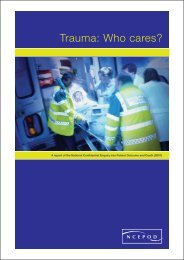A Transition Guide for All Services - Transition Information Network
A Transition Guide for All Services - Transition Information Network
A Transition Guide for All Services - Transition Information Network
- No tags were found...
You also want an ePaper? Increase the reach of your titles
YUMPU automatically turns print PDFs into web optimized ePapers that Google loves.
Developing a local transition pathway‘Pathways lay out the steps involved in transition and show who isinvolved at each stage and what the options may be at each stage.They are useful as they show clearly what the steps are and who hasresponsibility. They make what is a complicated process lookmanageable and comprehensive.’ 7?WhoDisabled young people, families, children’s social workers, transition socialworkers, adult team social workers, Connexions managers and personaladvisers (PA), healthcare and therapy staff, Jobcentre Plus advisers, headteachers, school staff, in<strong>for</strong>mation and advice workers, speech andlanguage therapists (SLT),?WhereStrategic transition groups, children with disabilities teams, local authorityeducation, schools, colleges, LSC, Connexions services, community nursingteams, physiotherapy services, occupational therapy services, Jobcentre Plus,adult social care teams, CAMHS, Children’s In<strong>for</strong>mation <strong>Services</strong>IntroductionOnce a strategic protocol is agreed and in place, it needs to be translatedinto something everyone concerned with the transition process canunderstand and act upon. Many areas have developed a transition pathwayto do this. A pathway gives the protocol operational detail and is veryeffective in mapping out how local services and individuals within them canwork most effectively together to support disabled young people and theirfamilies. The process is time consuming and needs an identified lead to takeit <strong>for</strong>ward. However, time spent working out and gaining agreement onhow the protocol will be translated into a pathway to work in practice canmake a significant difference to service quality.Chapter 1: The transition process<strong>Transition</strong> pathway7 Getting a Life,Summer 2005 edition,Council <strong>for</strong> DisabledChildren8 The ‘transition subgroup’ and role of‘<strong>Transition</strong> Champion’were first set out in theValuing People whitepaper. For furtherin<strong>for</strong>mation seewww.valuingpeople.gov.ukDeveloping a pathwayAt the core of each transition pathway will be the legal duties of eachstatutory service. The most effective pathways have input from disabledyoung people and their families and from a range of other agencies likely tobe providing support or services during the transition process. These willinclude Jobcentre Plus, leisure services and transport. Chapter 2 has detailson what each agency should provide.Many areas have a multi agency transition group which meets regularly todevelop the pathway and work with all agencies, families and disabledyoung people to monitor and improve local support. This group is often a‘sub group’ of the LDPB or the CYPSPB. This group may be chaired by a<strong>Transition</strong> Champion who will act as a point of contact <strong>for</strong> transition issueswithin the local authority area. 8 7
















